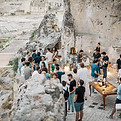
Matera
Ancient and otherworldly, Matera rises from the rocky ravine of southern Italy like a city carved from dreams. Here, prehistoric cave dwellings known as sassi honeycomb the hillside, their weathered stone steps and narrow passages telling a story that stretches back over 9,000 years. Candlelit restaurants and boutique hotels now inhabit these once-abandoned grottos, while church bells echo across limestone canyons at sunset. This UNESCO World Heritage site has transformed from Italy's "shame" to its crown jewel.
The Second Bethlehem
Matera, located in the Basilicata region of southern Italy, is one of the world's oldest continuously inhabited settlements, famous for its ancient cave dwellings known as "sassi." These remarkable habitations were carved into the limestone cliffs of a deep ravine, creating a labyrinthine network of homes, churches, and workshops dating back to prehistoric times. By the mid-20th century, the Sassi had become symbols of extreme poverty and poor living conditions, leading to government-mandated evacuation in the 1950s when residents were relocated to modern housing and the caves were abandoned.
Decades later, Matera underwent a remarkable transformation beginning in the 1980s. Restoration efforts converted the once-derelict cave dwellings into boutique hotels, restaurants, artisan shops, and museums. The city's extraordinary cultural and historical significance earned it UNESCO World Heritage status in 1993, and it was named the European Capital of Culture in 2019, completing its journey from "national shame" to international treasure.
Today, visitors can explore more than 150 rock-hewn churches with Byzantine frescoes, wander through the atmospheric stone streets, and experience the unique architecture that has made Matera a popular filming location, including for scenes in Mel Gibson's "The Passion of the Christ" and the James Bond film "No Time to Die." The city's remarkable resilience and reinvention have transformed it into one of Italy's most fascinating cultural destinations, offering insights into thousands of years of human habitation and adaptation.
Getting to Matera requires some planning as the city lacks its own airport. Most visitors arrive via the Bari International Airport (Karol Wojtyła Airport), located about 60 kilometers away, followed by a shuttle bus, private transfer, or rental car for the approximately one-hour journey. Alternatively, travelers can take a train to Ferrandina or Bari, then connect to Matera via local buses or though the main Matera train station (Matera Centrale), which is located outside the historic center.
Once in Matera, the historic Sassi districts are best explored on foot, as the ancient cave city features narrow pedestrian streets, staircases, and passageways that aren't accessible by vehicle. Walking is not only practical but also the best way to discover hidden corners, viewpoints, and the atmospheric qualities of this magical destination.
Things To Do And See
Matera offers visitors an extraordinary journey through history in its UNESCO-listed Sassi districts, where you can explore ancient cave dwellings, rock churches adorned with Byzantine frescoes, and underground cisterns that reveal thousands of years of human ingenuity. The city rewards those who wander its winding stone streets with breathtaking viewpoints and transportive architecture. Put down the map and get lost wandering through this magical and other worldly place, making sure to stroll along the picturesque Via Fiorentini, Via S. Antonio Abate, and Via Madonna delle Virtù.
Hiking through the rugged ravine surrounding Matera offers breathtaking views of the ancient city and access to the spectacular Belvedere Murgia Timone viewpoint across the gorge (click here for the trail starting point). From this natural balcony in the Murgia Materana Park, visitors can absorb the most iconic panorama of Matera's Sassi districts dramatically carved into the limestone cliffs, especially magical at sunset when the stone city glows golden. If you want to skip the hike but still enjoy the view, you can also drive to the overlook.

Enjoy The Many Viewpoints
Matera rewards explorers with numerous breathtaking vantage points, including Belvedere Piazzetta Pascoli with its postcard-perfect views over Sasso Caveoso, the elegant Convent of Saint Agostino courtyard overlooking the ravine, and the three-arched Belvedere Luigi Guerricchio. These strategic viewpoints offer different angles of the ancient cave dwellings cascading down the rocky landscape, allowing visitors to fully appreciate the otherworldly beauty and scale of this UNESCO site.

Visit The Rock Churches
Matera's rock-hewn churches represent remarkable examples of rupestrian art, with the Church of Saint Mary of Idris dramatically perched on a rocky outcrop, the frescoed interior of Chiesa di Santa Lucia alle Malve displaying Byzantine influences, Church of Saint Peter 'Barisano' featuring an underground network of burial chambers, the Chiesa di San Giovanni in Monterrone preserving vibrant medieval paintings, Chiesa di San Pietro Caveoso offering a striking façade against the ravine backdrop, and Chiesa di San Giovanni Battista showcasing unique architectural elements carved directly from the limestone.
Click here to purchase the Matera Google map with the above recommendations included.
Where To Eat
Matera's food scene celebrates the rustic traditions of Basilicata, featuring dishes that developed from peasant roots yet offer rich, complex flavors using simple, high-quality local ingredients. The culinary landscape ranges from family-run trattorias serving authentic regional specialties like orecchiette pasta with turnip greens, cruschi peppers, and hearty lamb stews, to sophisticated restaurants reimagining these traditions with contemporary techniques in atmospheric cave settings. Visitors can discover the region's distinctive bread—the iconic pane di Matera IGP with its distinctive golden crust—alongside exceptional cheeses like caciocavallo and pecorino, complemented by robust Basilicata wines such as Aglianico del Vulture, creating a culinary experience that's deeply connected to the territory's agricultural history and cultural identity.
Click here to purchase the Matera Google map with the above recommendations included.
Where To Drink
Matera's drinking scene perfectly balances tradition and innovation, featuring everything from historic cave bars serving local Basilicata wines to stylish aperitivo spots with panoramic views over the ancient Sassi districts. Visitors can savor the region's robust Aglianico del Vulture wines alongside artisanal amari and liqueurs made from local herbs and fruits, often enjoyed during the evening passeggiata when locals and tourists gather at outdoor terraces to watch the sunset transform the limestone city into a golden spectacle.
Click here to purchase the Matera Google map with the above recommendations included.
Where To Stay
Matera offers a truly unique accommodation experience centered around its famous cave dwellings, with luxury hotels, boutique B&Bs, and affordable guesthouses thoughtfully integrated into the ancient Sassi districts. These cave accommodations range from rustic to opulent, with skilled renovations that maintain original architectural features like vaulted ceilings and stone archways while incorporating modern amenities, creating spaces that balance historical authenticity with contemporary comfort. Beyond the caves, visitors can also find conventional hotels in Matera's newer districts, though most travelers prefer the extraordinary experience of staying within the UNESCO-listed neighborhoods, where waking up inside centuries-old stone chambers provides an immersive connection to the city's remarkable history and distinctive sense of place.
Click here to purchase the Matera Google map with the above recommendations included.
Nearby Gems
Matera's dramatic setting within the Basilicata region offers easy access to diverse natural landscapes and cultural attractions, from the rugged Murgia National Park with its network of hiking trails and hidden rupestrian churches to the pristine beaches of both the Ionian and Tyrrhenian coasts within an hour's drive. Day-trippers can explore charming nearby towns like Altamura, famous for its distinctive bread and prehistoric archaeological sites, or Gravina in Puglia with its impressive canyon and bridge reminiscent of Matera's own landscape.

Explore Altamura
Located just outside Matera, the Crypt of Original Sin houses spectacular 9th-century frescoes that have earned it the nickname "Sistine Chapel of rupestrian art." These remarkably preserved Byzantine-style paintings depicting biblical scenes were created by an anonymous artist known as "the Flower Painter of Matera," offering visitors a glimpse into early Christian worship in the region's cave churches. Tickets are required in advance and can be purchased here.
Just a short drive from Matera, Altamura charms visitors with its well-preserved medieval center and renowned culinary heritage centered around its famous DOP-protected bread baked in traditional wood-fired ovens. The town also boasts significant archaeological importance with the Cathedral of Santa Maria Assunta and the nearby discovery of "Altamura Man," a complete Neanderthal skeleton embedded in stalagmites within a local karst cave.

Explore Gravina
The town of Gravina in Puglia, just across the regional border from Matera, features a dramatic setting atop a ravine crossed by a Roman-origin aqueduct bridge that offers spectacular views reminiscent of Matera's landscape (and seen in the James Bond movie No Time To Die). Visitors can explore an underground city of cellars, granaries, and crypts beneath the historical center, along with impressive churches, palatial residences, and traditional restaurants specializing in the town's distinctive Gravina cheese and robust red wines.
Click here to purchase the Matera Google map with the above recommendations included.









.jpg)






























